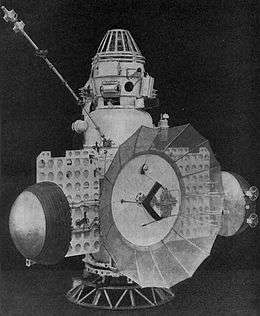3MV
The 3MV planetary probe (short for 3rd generation Mars-Venus) is a designation for a common design used by early Soviet unmanned probes to Mars and Venus. It was an incremental improvement of earlier 2MV probes and was used for Zond 1, Zond 2 and Zond 3 missions to Mars as well as several Venera probes. It was standard practice of the Soviet space program to use standardized components as much as possible. All probes shared the same general characteristics and differed only in equipment necessary for specific missions. Each probe also incorporated improvements based on experience with earlier missions. It was superseded by the 4MV family.

Design
The probe consisted of three primary parts.
Orbital Compartment
The core of the stack was a pressurized compartment called the Orbital Compartment. This part housed the spacecraft's control electronics, radio transmitters and receivers, batteries, astro-orientation equipment, and so on. The compartment was pressurized to around 100 kPa and thermally controlled to simulate earth-like conditions, which removed the need for special electronic components that could reliably operate in extreme conditions (on Zond 1 the module depressurized in flight, severely damaging the probe's systems).
Mounted on the outside of the Orbital Compartment were two solar panels which supplied power to the spacecraft. They were folded against the body of the probe during launch and were only deployed when the craft was already on its interplanetary trajectory. On the ends of each solar panel was a hemispherical radiator which radiated excess heat from the orbital compartment into space through a coolant loop.
Also mounted on the Orbital Compartment was a 2 m parabolic high-gain antenna, used for long-range communications. Depending on the mission, the probe also used other antennas (for example, for communication with probes on the planet's surface).
Planetary Compartment
Below the Orbital Compartment was a second pressurized compartment called the Planetary Compartment. Depending on the mission the Planetary Compartment either housed scientific equipment for orbital observation of the planet or was designed to detach and land on the planet's surface.
Engine
Course correction capabilities were provided by a KDU 414 engine attached to the top of the Orbital Compartment. It provided a maximum thrust of around 2 kN and used UDMH and nitric acid as propellants. Attitude control was achieved by several small cold gas thrusters.
The whole stack was 3.6 m high and weighted around 1000 kg.
Variants
- Venera 3MV-1A: Cosmos 21 (3MV-1 No.1), 3MV-1A (failure)
- Venera 3MV-1: Zond 3MV-1 No.2 (failure), Cosmos 27 (3MV-1 No.3), Zond 1 (3MV-1 No.4))
- Mars 3MV-4A: Zond 2 (3MV-4A No.2), Zond 3 (3MV-4A No.3)
- Venera 3MV-4: Venera 2 (3MV-4 No.4), Cosmos 96 (3MV-4 No.6)
- Venera 3MV-3: Venera 3 (3MV-3 No.1), Venera 3MV-3
- Venera 3V (V-70): Venera 7 (V-70 s/n 630), Cosmos 359 (V-70 s/n 631)
- Venera 3V (V-72): Venera 8 (V-72 s/n 670), Cosmos 482 (V-72 s/n 671)
See also
References
- "The Mystery of Zond 2" by Andrew Lepage, EJASA, April 1991, retrieved on January 21, 2012
- "The overview of the Russian launches toward Venus" by Anatoly Zak, July 2007, retrieved on December 2, 2007
- "The overview of the Russian launches toward Mars" by Anatoly Zak, August 2007, retrieved on December 2, 2007